
This article was last updated on January 9, 2025
Canada: ![]() Oye! Times readers Get FREE $30 to spend on Amazon, Walmart…
Oye! Times readers Get FREE $30 to spend on Amazon, Walmart…
USA: ![]() Oye! Times readers Get FREE $30 to spend on Amazon, Walmart…
Oye! Times readers Get FREE $30 to spend on Amazon, Walmart…
Table of Contents
Scientists in Antarctica drill 3 kilometer long ice core
In Antarctica, a team of scientists has recovered an ice core almost 3 kilometers long after ten years of drilling. With this they have reached ice that is at least 1.2 million years old.
They want to examine the ice to learn more about how Earth’s atmosphere and climate have changed. For example, the kilometre-long ice bar can provide insight into when the ice age began in Antarctica, says glaciologist Carlo Barbante, who was involved in the project. And about when the ice age cycles slowed down from once every 41,000 years to once every approximately 120,000 years.
Technologically advanced operation
Between the ice and the rock bottom at a depth of 2.8 kilometers there is also an intermediate layer with sediment, micro-organisms, viruses and bacteria. “That can teach us a lot about how life developed in these distant times,” says Barbante.
Retrieving the ice core was a technologically advanced operation. The scientists worked in shifts to extract the ice in sections of about 4 to 5 meters long with a kind of enormous apple corer.
“You can imagine that it is not easy to work here,” says another researcher involved, Federico Scoto. “We work under extreme conditions every day. The temperature was never higher than -26, -27 degrees Celsius.” In the cold winters it was not possible to drill at all.
Greenhouse gases
Analysis of previously recovered portions of the ice core has already established that concentrations of greenhouse gases, such as carbon dioxide and methane, have never exceeded levels seen since the start of the Industrial Revolution.
“Today we are seeing carbon dioxide levels that are 50 percent higher than the highest levels we have had in the last 800,000 years,” Barbante said.
The ice is now being sawn into smaller pieces and brought to the edge of Antarctica by sled. It will then be transported by boat to Europe for further research. The bars must remain cooled to -50 degrees during the entire journey. All studies are expected to be completed in two years.

Be the first to comment